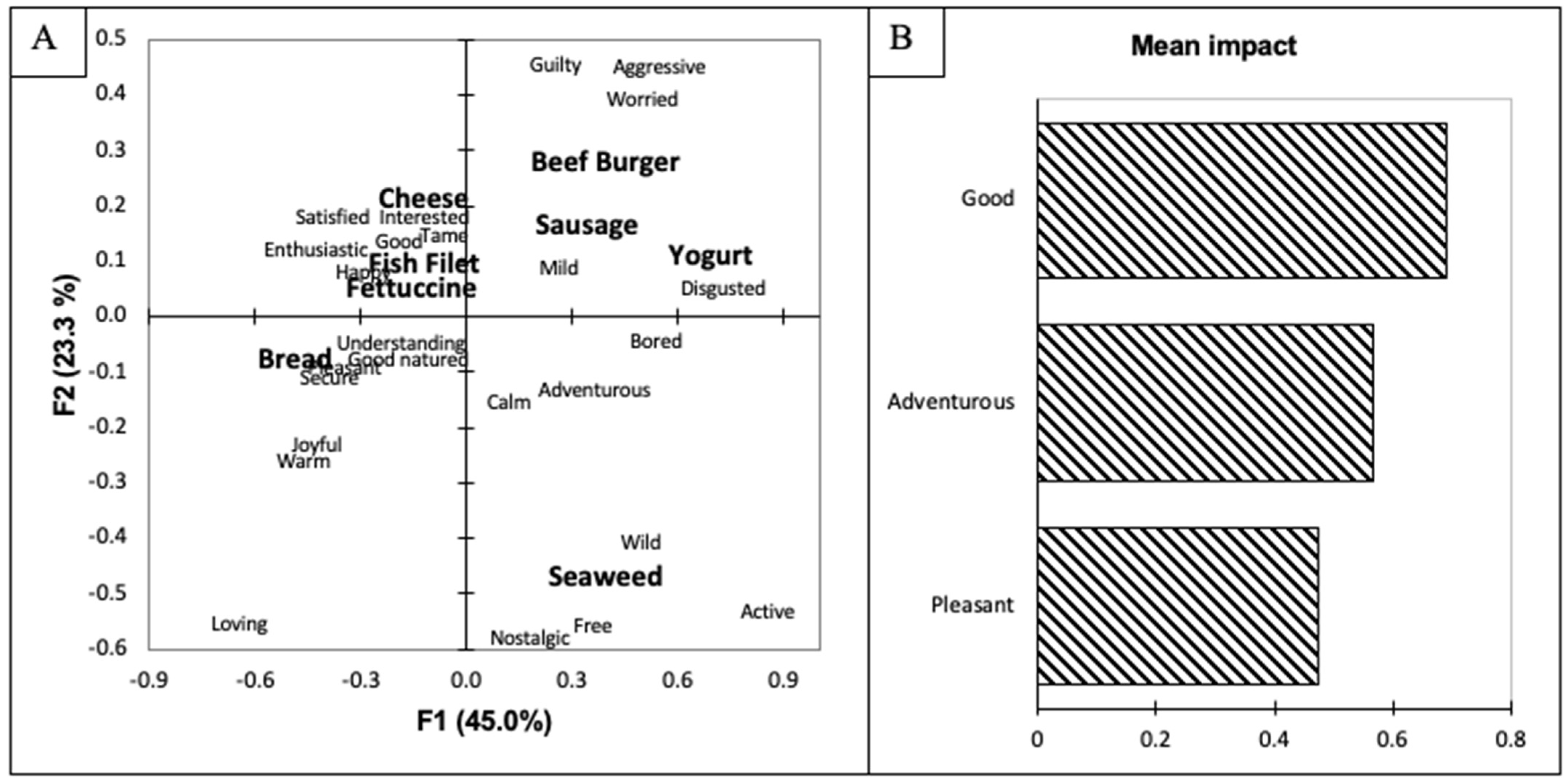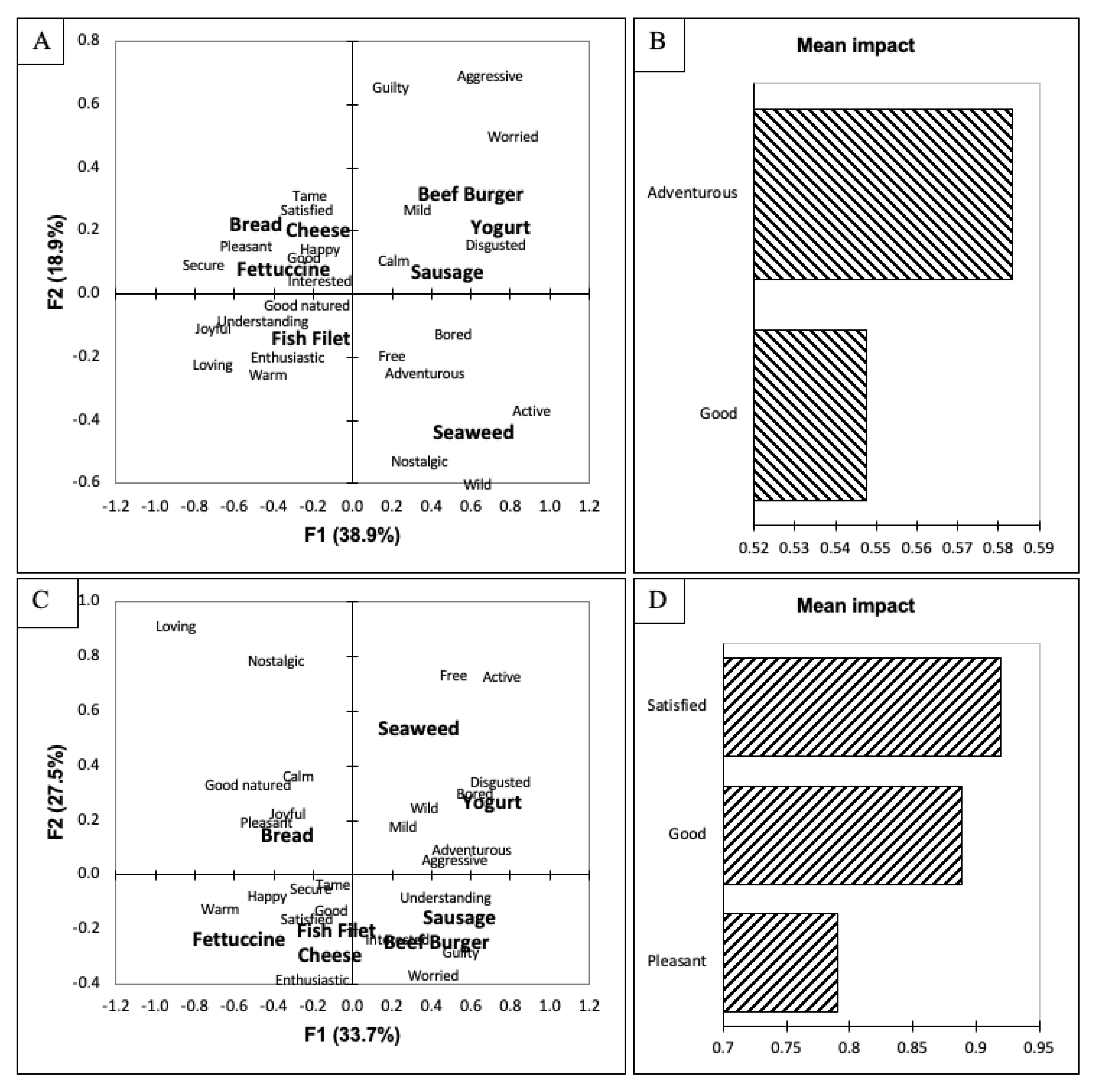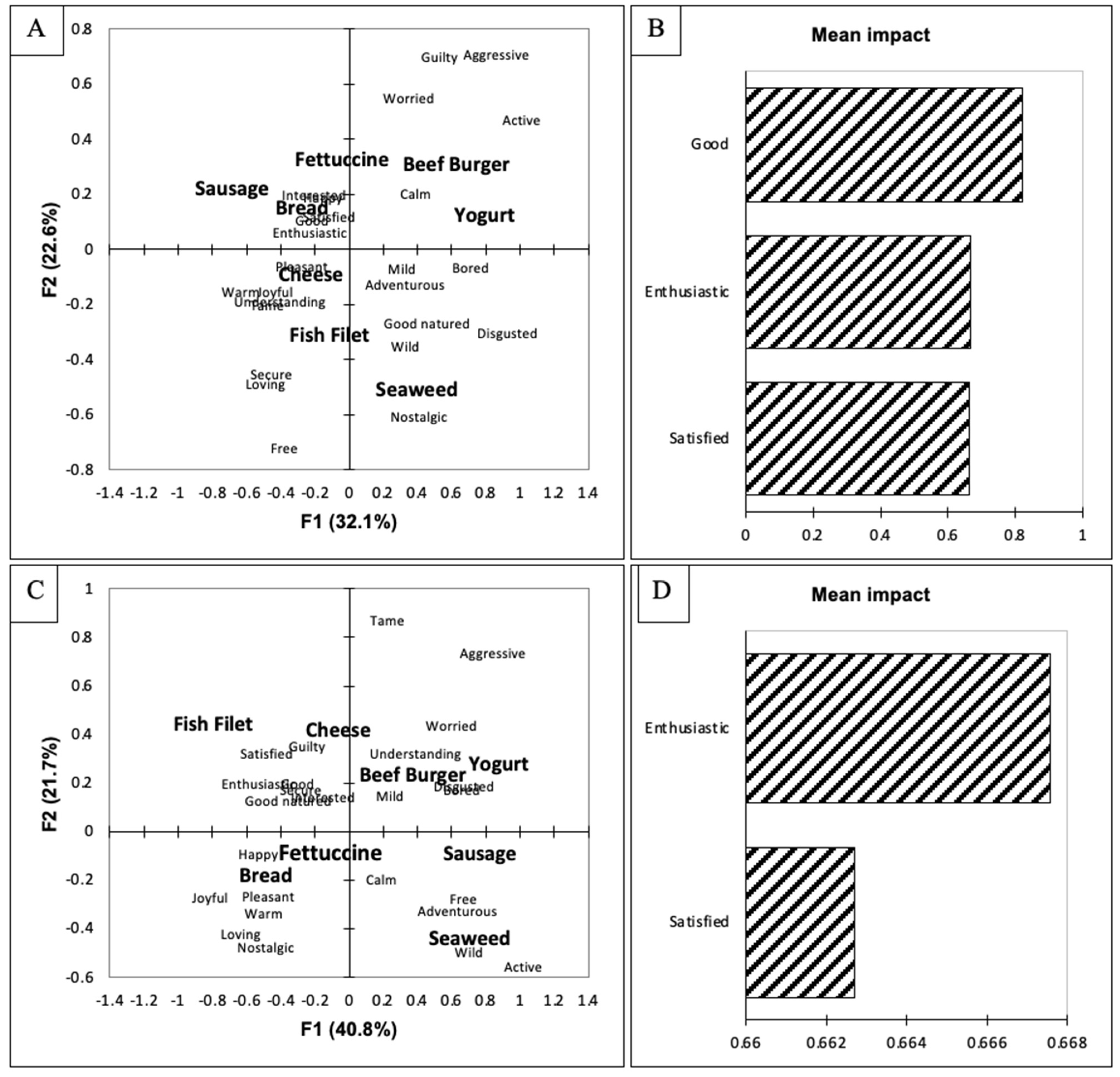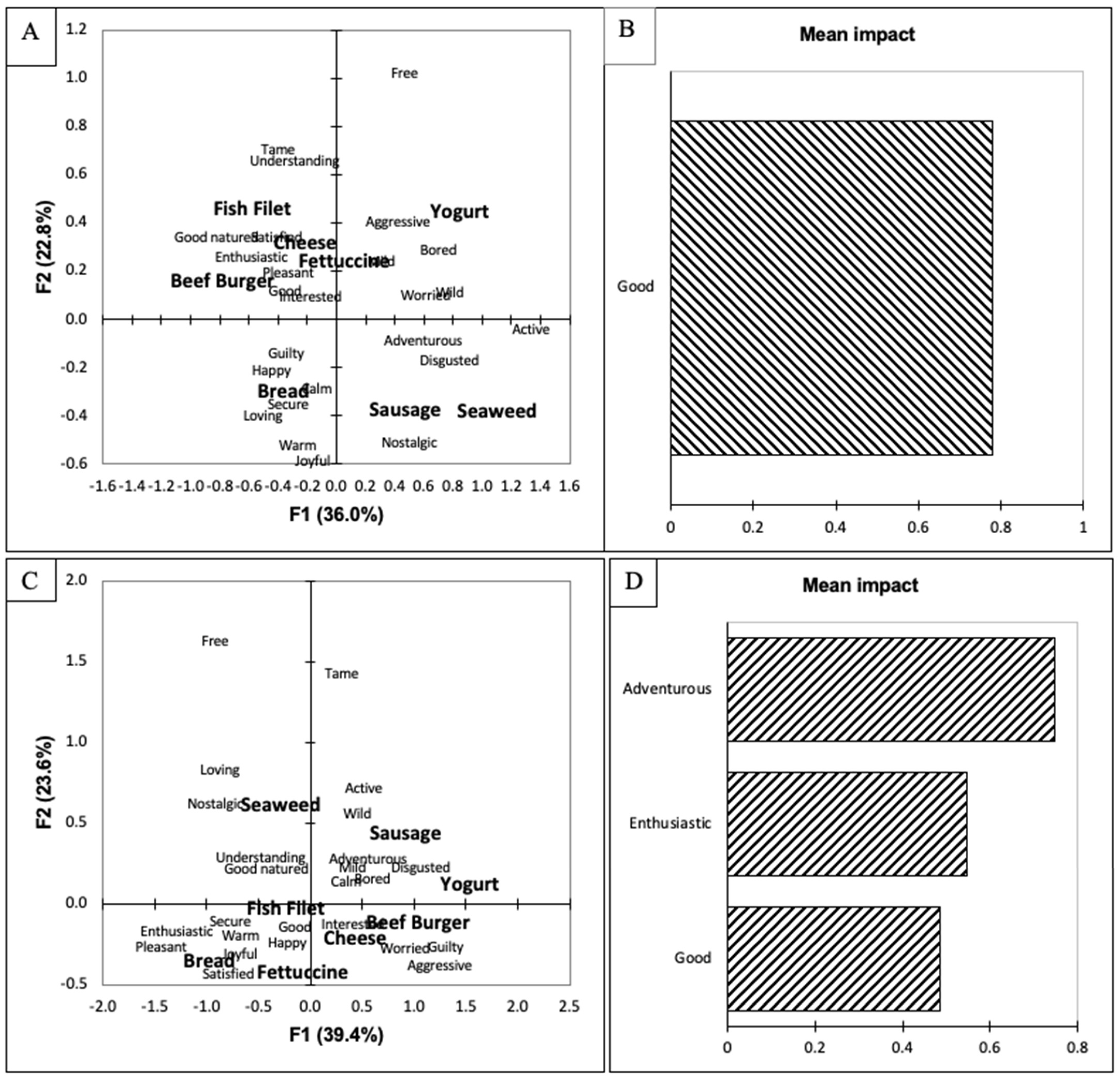Do Consumers Want Seaweed in Their Food? A Study Evaluating Emotional Responses to Foods Containing Seaweed
Abstract
:1. Introduction
2. Materials and Methods
2.1. Food Products
2.2. Participants
2.3. Questionnaire
2.4. Statistical Analysis
3. Results and Discussion
3.1. Seaweed Product Development
3.2. Segmentation
3.3. Limitations
4. Conclusions
Supplementary Materials
Author Contributions
Funding
Institutional Review Board Statement
Informed Consent Statement
Data Availability Statement
Acknowledgments
Conflicts of Interest
References
- Butterfield, N.J. Bangiomorpha pubescens n. gen., n. sp.: Implications for the evolution of sex, multicellularity, and the Mesoproterozoic/Neoproterozoic radiation of eukaryotes. Paleobiology 2000, 26, 386–404. [Google Scholar] [CrossRef]
- Mouritsen, O.G.; Rhatigan, P.; Pérez-Lloréns, J.L. World cuisine of seaweeds: Science meets gastronomy. Int. J. Gastron. Food Sci. 2018, 14, 55–65. [Google Scholar] [CrossRef]
- Chung, I.K.; Sondak, C.F.A.; Beardall, J. The future of seaweed aquaculture in a rapidly changing world. Eur. J. Phycol. 2017, 52, 495–505. [Google Scholar] [CrossRef]
- Kumar, Y.; Tarafdar, A.; Kumar, D.; Badgujar, P.C. Effect of Indian brown seaweed Sargassum wightii as a functional ingredient on the phytochemical content and antioxidant activity of coffee beverage. J. Food Sci. Technol. 2019, 56, 4516–4525. [Google Scholar] [CrossRef] [PubMed]
- McDermid, K.J.; Stuercke, B. Nutritional composition of edible Hawaiian seaweeds. J. Appl. Phycol. 2003, 15, 513–524. [Google Scholar] [CrossRef]
- Kumar, M.; Kumari, P.; Trivedi, N.; Shukla, M.K.; Gupta, V.; Reddy, C.R.K.; Jha, B. Minerals, PUFAs and antioxidant properties of some tropical seaweeds from Saurashtra coast of India. J. Appl. Phycol. 2011, 23, 797–810. [Google Scholar] [CrossRef]
- Sánchez-Machado, D.I.; López-Cervantes, J.; López-Hernández, J.; Paseiro-Losada, P. Fatty acids, total lipid, protein and ash contents of processed edible seaweeds. Food Chem. 2004, 85, 439–444. [Google Scholar] [CrossRef]
- Wells, M.L.; Potin, P.; Craigie, J.S.; Raven, J.A.; Merchant, S.S.; Helliwell, K.E.; Smith, A.G.; Camire, M.E.; Brawley, S.H. Algae as nutritional and functional food sources: Revisiting our understanding. J. Appl. Phycol. 2017, 29, 949–982. [Google Scholar] [CrossRef] [PubMed]
- Rasyid, A. Evaluation of Nutritional Composition of The Dried Seaweed Ulva lactuca from Pameungpeuk Waters, Indonesia. Trop. Life Sci. Res. 2017, 28, 119–125. [Google Scholar] [CrossRef]
- Sakthivel, R.; Pandima Devi, K. Evaluation of physicochemical properties, proximate and nutritional composition of Gracilaria edulis collected from Palk Bay. Food Chem. 2015, 174, 68–74. [Google Scholar] [CrossRef] [PubMed]
- Kadam, S.U.; Álvarez, C.; Tiwari, B.K.; O’Donnell, C.P. Extraction and characterization of protein from Irish brown seaweed Ascophyllum nodosum. Food Res. Int. 2017, 99, 1021–1027. [Google Scholar] [CrossRef] [PubMed]
- Mæhre, H.K.; Malde, M.K.; Eilertsen, K.-E.; Elvevoll, E.O. Characterization of protein, lipid and mineral contents in common Norwegian seaweeds and evaluation of their potential as food and feed. J. Sci. Food Agric. 2014, 94, 3281–3290. [Google Scholar] [CrossRef]
- Syad, A.N.; Shunmugiah, K.P.; Kasi, P.D. Seaweeds as nutritional supplements: Analysis of nutritional profile, physicochemical properties and proximate composition of G. acerosa and S. wightii. Biomed. Prev. Nutr. 2013, 3, 139–144. [Google Scholar] [CrossRef]
- Cofrades, S.; Benedí, J.; Garcimartin, A.; Sánchez-Muniz, F.J.; Jimenez-Colmenero, F. A comprehensive approach to formulation of seaweed-enriched meat products: From technological development to assessment of healthy properties. Food Res. Int. 2017, 99, 1084–1094. [Google Scholar] [CrossRef] [PubMed]
- Gómez-Ordóñez, E.; Jiménez-Escrig, A.; Rupérez, P. Dietary fibre and physicochemical properties of several edible seaweeds from the northwestern Spanish coast. Food Res. Int. 2010, 43, 2289–2294. [Google Scholar] [CrossRef]
- Taboada, M.C.; Millán, R.; Miguez, M.I. Nutritional value of the marine algae wakame (Undaria pinnatifida) and nori (Porphyra purpurea) as food supplements. J. Appl. Phycol. 2013, 25, 1271–1276. [Google Scholar] [CrossRef]
- Arufe, S.; Della Valle, G.; Chiron, H.; Chenlo, F.; Sineiro, J.; Moreira, R. Effect of brown seaweed powder on physical and textural properties of wheat bread. Eur. Food Res. Technol. 2018, 244, 1–10. [Google Scholar] [CrossRef]
- Chang, H.C.; Wu, L.-C. Texture and Quality Properties of Chinese Fresh Egg Noodles Formulated with Green Seaweed [Monostroma nitidum] Powder. J. Food Sci. 2008, 73, S398–S404. [Google Scholar] [CrossRef]
- Dolea, D.; Rizo, A.; Fuentes, A.; Barat, J.; Fernández-Segovia, I. Effect of thyme and oregano essential oils on the shelf life of salmon and seaweed burgers. Food Sci. Technol. Int. 2018, 24, 394–403. [Google Scholar] [CrossRef]
- Nuñez, M.; Picon, A. Seaweeds in yogurt and quark supplementation: Influence of five dehydrated edible seaweeds on sensory characteristics. Int. J. Food Sci. Technol. 2017, 52, 431–438. [Google Scholar] [CrossRef]
- Jaeger, S.R.; Hedderley, D.I. Impact of individual differences in emotional intensity and private body consciousness on EsSense Profile® responses. Food Qual. Prefer. 2013, 27, 54–62. [Google Scholar] [CrossRef]
- Cardello, A.V.; Meiselman, H.L.; Schutz, H.G.; Craig, C.; Given, Z.; Lesher, L.L.; Eicher, S. Measuring emotional responses to foods and food names using questionnaires. Food Qual. Prefer. 2012, 24, 243–250. [Google Scholar] [CrossRef]
- Ferrarini, R.; Carbognin, C.; Casarotti, E.M.; Nicolis, E.; Nencini, A.; Meneghini, A.M. The emotional response to wine consumption. Food Qual. Prefer. 2010, 21, 720–725. [Google Scholar] [CrossRef]
- King, S.C.; Meiselman, H.L. Development of a method to measure consumer emotions associated with foods. Food Qual. Prefer. 2010, 21, 168–177. [Google Scholar] [CrossRef]
- Jaeger, S.R.; Swaney-Stueve, M.; Chheang, S.L.; Hunter, D.C.; Pineau, B.; Ares, G. An assessment of the CATA-variant of the EsSense Profile®. Food Qual. Prefer. 2018, 68, 360–370. [Google Scholar] [CrossRef]
- Jaeger, S.R.; Cardello, A.V.; Schutz, H.G. Emotion questionnaires: A consumer-centric perspective. Food Qual. Prefer. 2013, 30, 229–241. [Google Scholar] [CrossRef]
- Nestrud, M.A.; Meiselman, H.L.; King, S.C.; Lesher, L.L.; Cardello, A.V. Development of EsSense25, a shorter version of the EsSense Profile®. Food Qual. Prefer. 2016, 48, 107–117. [Google Scholar] [CrossRef]
- Leigh Gibson, E. Emotional influences on food choice: Sensory, physiological and psychological pathways. Physiol. Behav. 2006, 89, 53–61. [Google Scholar] [CrossRef]
- Macht, M.; Simons, G. Emotions and eating in everyday life. Appetite 2000, 35, 65–71. [Google Scholar] [CrossRef]
- Macht, M.; Gerer, J.; Ellgring, H. Emotions in overweight and normal-weight women immediately after eating foods differing in energy. Physiol. Behav. 2003, 80, 367–374. [Google Scholar] [CrossRef]
- Brunsø, K.; Grunert, K.G. Cross-Cultural Similarities and Differences in Shopping for Food. J. Bus. Res. 1998, 42, 145–150. [Google Scholar] [CrossRef]
- Brunsø, K.; Birch, D.; Memery, J.; Temesi, Á.; Lakner, Z.; Lang, M.; Dean, D.; Grunert, K.G. Core dimensions of food-related lifestyle: A new instrument for measuring food involvement, innovativeness and responsibility. Food Qual. Prefer. 2021, 91, 104192. [Google Scholar] [CrossRef]
- Pliner, P.; Hobden, K. Development of a scale to measure the trait of food neophobia in humans. Appetite 1992, 19, 105–120. [Google Scholar] [CrossRef]
- Friedman, M.I.; Ulrich, P.; Mattes, R.D. A Figurative Measure of Subjective Hunger Sensations. Appetite 1999, 32, 395–404. [Google Scholar] [CrossRef]
- Ng, M.; Chaya, C.; Hort, J. Beyond liking: Comparing the measurement of emotional response using EsSense Profile and consumer defined check-all-that-apply methodologies. Food Qual. Prefer. 2013, 28, 193–205. [Google Scholar] [CrossRef]
- Meyners, M.; Castura, J. Check-All-That-Apply Questions. Nov. Tech. Sens. Charact. Consum. Profiling 2014, 271–305. [Google Scholar] [CrossRef]
- Fonseca, F.G.A.; Esmerino, E.A.; Filho, E.R.T.; Ferraz, J.P.; da Cruz, A.G.; Bolini, H.M.A. Novel and successful free comments method for sensory characterization of chocolate ice cream: A comparative study between pivot profile and comment analysis. J. Dairy Sci. 2016, 99, 3408–3420. [Google Scholar] [CrossRef]
- Laaksonen, O.; Knaapila, A.; Niva, T.; Deegan, K.C.; Sandell, M. Sensory properties and consumer characteristics contributing to liking of berries. Food Qual. Prefer. 2016, 53, 117–126. [Google Scholar] [CrossRef]
- Romaniw, O.C.; Rajpal, R.; Duncan, A.M.; Keller, H.H.; Duizer, L.M. Nutrition in Disguise: Effects of Food Neophobia, Healthy Eating Interests and Provision of Health Information on Liking and Perceptions of Nutrient-Dense Foods in Older Adults. Foods 2021, 10, 60. [Google Scholar] [CrossRef]
- Gullón, B.; Gagaoua, M.; Barba, F.J.; Gullón, P.; Zhang, W.; Lorenzo, J.M. Seaweeds as promising resource of bioactive compounds: Overview of novel extraction strategies and design of tailored meat products. Trends Food Sci. Technol. 2020, 100, 1–18. [Google Scholar] [CrossRef]
- Roohinejad, S.; Koubaa, M.; Barba, F.J.; Saljoughian, S.; Amid, M.; Greiner, R. Application of seaweeds to develop new food products with enhanced shelf-life, quality and health-related beneficial properties. Food Res. Int. 2017, 99, 1066–1083. [Google Scholar] [CrossRef] [PubMed]
- Birch, D.; Skallerud, K.; Paul, N.A. Who are the future seaweed consumers in a Western society? Insights from Australia. Br. Food J. 2018, 121, 603–615. [Google Scholar] [CrossRef] [Green Version]
- Birch, D.; Skallerud, K.; Paul, N. Who Eats Seaweed? An Australian Perspective. J. Int. Food Agribus. Mark. 2019, 31, 329–351. [Google Scholar] [CrossRef]
- Beyts, C.; Chaya, C.; Dehrmann, F.; James, S.; Smart, K.; Hort, J. A comparison of self-reported emotional and implicit responses to aromas in beer. Food Qual. Prefer. 2017, 59, 68–80. [Google Scholar] [CrossRef]
- Kam, K.; Murray, J.M.; Arcot, J.; Ward, R. Fortification of parboiled rice with folic acid: Consumer acceptance and sensory evaluation. Food Res. Int. 2012, 49, 354–363. [Google Scholar] [CrossRef]
- Danner, L.; Ristic, R.; Johnson, T.E.; Meiselman, H.L.; Hoek, A.C.; Jeffery, D.W.; Bastian, S.E. Context and wine quality effects on consumers’ mood, emotions, liking and willingness to pay for Australian Shiraz wines. Food Res. Int. 2016, 89, 254–265. [Google Scholar] [CrossRef] [PubMed]
- Chonpracha, P.; Ardoin, R.; Gao, Y.; Waimaleongora-ek, P.; Tuuri, G.; Prinyawiwatkul, W. Effects of Intrinsic and Extrinsic Visual Cues on Consumer Emotion and Purchase Intent: A Case of Ready-to-Eat Salad. Foods 2020, 9, 396. [Google Scholar] [CrossRef] [Green Version]
- Poonnakasem, N.; Pujols, K.D.; Chaiwanichsiri, S.; Laohasongkram, K.; Prinyawiwatkul, W. Different Oils and Health Benefit Statements Affect Physicochemical Properties, Consumer Liking, Emotion, and Purchase Intent: A Case of Sponge Cake. J. Food Sci. 2016, 81, S165–S173. [Google Scholar] [CrossRef] [PubMed]
- Spinelli, S.; Masi, C.; Dinnella, C.; Zoboli, G.P.; Monteleone, E. How does it make you feel? A new approach to measuring emotions in food product experience. Food Qual. Prefer. 2014, 37, 109–122. [Google Scholar] [CrossRef]
- Gutjar, S.; Dalenberg, J.R.; de Graaf, C.; de Wijk, R.A.; Palascha, A.; Renken, R.J.; Jager, G. What reported food-evoked emotions may add: A model to predict consumer food choice. Food Qual. Prefer. 2015, 45, 140–148. [Google Scholar] [CrossRef]
- Ladhari, R. The movie experience: A revised approach to determinants of satisfaction. J. Bus. Res. 2007, 60, 454–462. [Google Scholar] [CrossRef]
- Mabeau, S.; Fleurence, J. Seaweed in food products: Biochemical and nutritional aspects. Trends Food Sci. Technol. 1993, 4, 103–107. [Google Scholar] [CrossRef]
- Marcus, J.B. Enhancing umami taste in foods. In Modifying Flavour in Food [Internet]; Taylor, A., Hort, J., Eds.; Woodhead Publishing: Sawston, UK, 2007. [Google Scholar]
- Mouritsen, O.G.; Williams, L.; Bjerregaard, R.; Duelund, L. Seaweeds for umami flavour in the New Nordic Cuisine. Flavour 2012, 1, 4. [Google Scholar] [CrossRef] [Green Version]
- Cardoso, S.M.; Pereira, O.R.; Seca, A.M.L.; Pinto, D.C.G.A.; Silva, A.M.S. Seaweeds as Preventive Agents for Cardiovascular Diseases: From Nutrients to Functional Foods. Mar. Drugs 2015, 13, 6838–6865. [Google Scholar] [CrossRef] [PubMed] [Green Version]
- Rioux, L.-E.; Beaulieu, L.; Turgeon, S.L. Seaweeds: A traditional ingredients for new gastronomic sensation. Food Hydrocoll. 2017, 68, 255–265. [Google Scholar] [CrossRef]
- Prabhasankar, P.; Ganesan, P.; Bhaskar, N.; Hirose, A.; Stephen, N.; Gowda, L.R.; Hosokawa, M.; Miyashita, K. Edible Japanese seaweed, wakame (Undaria pinnatifida) as an ingredient in pasta: Chemical, functional and structural evaluation. Food Chem. 2009, 115, 501–508. [Google Scholar] [CrossRef]
- Kumoro, A.; Johnny, D.; Alfilovita, D. Incorporation of microalgae and seaweed in instant fried wheat noodles manufacturing: Nutrition and culinary properties study. Int. Food Res. J. 2016, 23, 715–722. [Google Scholar]
- Lamont, T.; McSweeney, M. Consumer acceptability and chemical composition of whole-wheat breads incorporated with brown seaweed (Ascophyllum nodosum) or red seaweed (Chondrus crispus). J. Sci. Food Agric. 2021, 101, 1507–1514. [Google Scholar] [CrossRef]
- Singh, C.B.; Xavier, K.A.M.; Deshmukhe, G.; Gudipati, V.; Shitole, S.S.; Balange, A.K. Fortification of Extruded Product with Brown Seaweed (Sargassum tenerrimum) and Its Process Optimization by Response Surface Methodology. Waste Biomass Valorization 2018, 9, 755–764. [Google Scholar] [CrossRef]
- Mamat, H.; Akanda, J.M.H.; Zainol, M.K.; Ling, Y.A. The Influence of Seaweed Composite Flour on the Physicochemical Properties of Muffin. J Aquat Food Prod Technol. 2018, 27, 635–642. [Google Scholar] [CrossRef]
- Chapman, A.S.; Stévant, P.; Larssen, W.E. Food or fad? Challenges and opportunities for including seaweeds in a Nordic diet. Bot. Mar. 2015, 58, 423–433. [Google Scholar] [CrossRef]
- Senthil, A.; Mamatha, B.S.; Vishwanath, P.; Bhat, K.K.; Ravishankar, G.A. Studies on development and storage stability of instant spice adjunct mix from seaweed [Eucheuma]. J. Food Sci. Technol. 2011, 48, 712–717. [Google Scholar] [CrossRef] [Green Version]
- Etemadian, Y.; Shabanpour, B.; Ramzanpour, Z.; Shaviklo, A.R.; Kordjazi, M. Production of the corn snack seasoned with brown seaweeds and their characteristics. J. Food Meas. Charact. 2018, 12, 2068–2079. [Google Scholar] [CrossRef]
- Chee, C.P.; Gallaher, J.J.; Djordjevic, D.; Faraji, H.; McClements, D.J.; Decker, E.A.; Hollender, R.; Peterson, D.G.; Roberts, R.F.; Coupland, J.N. Chemical and sensory analysis of strawberry flavoured yogurt supplemented with an algae oil emulsion. J. Dairy Res. 2005, 72, 311–316. [Google Scholar] [CrossRef] [PubMed]
- Stévant, P.; Ólafsdóttir, A.; Déléris, P.; Dumay, J.; Fleurence, J.; Ingadóttir, B.; Jónsdóttir, R.; Ragueneau, É.; Rebours, C.; Rustad, T. Semi-dry storage as a maturation process for improving the sensory characteristics of the edible red seaweed dulse (Palmaria palmata). Algal Res. 2020, 51, 102048. [Google Scholar] [CrossRef]
- Vilar, E.G.; O’Sullivan, M.G.; Kerry, J.P.; Kilcawley, K.N. A chemometric approach to characterize the aroma of selected brown and red edible seaweeds / extracts. J. Sci. Food Agric. 2021, 101, 1228–1238. [Google Scholar] [CrossRef]
- Peinado, I.; Girón, J.; Koutsidis, G.; Ames, J.M. Chemical composition, antioxidant activity and sensory evaluation of five different species of brown edible seaweeds. Food Res. Int. 2014, 66, 36–44. [Google Scholar] [CrossRef] [Green Version]
- Frøst, M.B.; Hartmann, A.; Petersen, M.A.; Duelund, L.; Mouritsen, O.G. Odour-induced umami—Olfactory contribution to umami taste in seaweed extracts (dashi) by sensory interactions. Int. J. Gastron. Food Sci. 2021, 25, 100363. [Google Scholar] [CrossRef]
- Dawczynski, C.; Schubert, R.; Jahreis, G. Amino acids, fatty acids, and dietary fibre in edible seaweed products. Food Chem. 2007, 103, 891–899. [Google Scholar] [CrossRef]
- Gupta, S.; Abu-Ghannam, N. Recent developments in the application of seaweeds or seaweed extracts as a means for enhancing the safety and quality attributes of foods. Innov. Food Sci. Emerg. Technol. 2011, 12, 600–609. [Google Scholar] [CrossRef]
- Murai, U.; Yamagishi, K.; Kishida, R.; Iso, H. Impact of seaweed intake on health. Eur. J. Clin. Nutr. 2020, 202, 877–889. [Google Scholar] [CrossRef] [PubMed]
- Nielsen, C.W.; Rustad, T.; Holdt, S.L. Vitamin C from Seaweed: A Review Assessing Seaweed as Contributor to Daily Intake. Foods 2021, 10, 198. [Google Scholar] [CrossRef] [PubMed]
- Losada-Lopez, C.; Dopico, D.C.; Faína-Medín, J.A. Neophobia and seaweed consumption: Effects on consumer attitude and willingness to consume seaweed. Int. J. Gastron. Food Sci. 2021, 24, 100338. [Google Scholar] [CrossRef]
- Palmieri, N.; Forleo, M.B. The potential of edible seaweed within the western diet. A segmentation of Italian consumers. Int. J. Gastron. Food Sci. 2020, 20, 100202. [Google Scholar] [CrossRef]
- Cornell, C.E.; Rodin, J.; Weingarten, H. Stimulus-induced eating when satiated. Physiol. Behav. 1989, 45, 695–704. [Google Scholar] [CrossRef]
- de-Magistris, T.; Gracia, A. Assessing Projection Bias in Consumers’ Food Preferences. PLoS ONE 2016, 11, e0146308. [Google Scholar] [CrossRef] [Green Version]
- Jaeger, S.R.; Chheang, S.L.; Jin, D.; Ryan, G.; Worch, T. The negative influence of food neophobia on food and beverage liking: Time to look beyond extreme groups analysis? Food Qual. Pref. 2021, 92, 104217. [Google Scholar] [CrossRef]
- Yang, Q.; Shen, Y.; Foster, T.; Hort, J. Measuring consumer emotional response and acceptance to sustainable food products. Food Res. Int. 2020, 131, 108992. [Google Scholar] [CrossRef]
- Casini, L.; Boncinelli, F.; Contini, C.; Gerini, F.; Scozzafava, G.; Alfnes, F. Heterogeneous preferences with respect to food preparation time: Foodies and quickies. Food Qual. Prefer. 2019, 71, 233–241. [Google Scholar] [CrossRef]
- Kim, S.; Lee, K.; Lee, Y. Selection attributes of home meal replacement by food-related lifestyles of single-person households in South Korea. Food Qual. Prefer. 2018, 66, 44–51. [Google Scholar] [CrossRef]
- Borgogno, M.; Favotto, S.; Corazzin, M.; Cardello, A.V.; Piasentier, E. The role of product familiarity and consumer involvement on liking and perceptions of fresh meat. Food Qual. Prefer. 2015, 44, 139–147. [Google Scholar] [CrossRef]
- Torrico, D.D.; Fuentes, S.; Gonzalez Viejo, C.; Ashman, H.; Dunshea, F.R. Cross-cultural effects of food product familiarity on sensory acceptability and non-invasive physiological responses of consumers. Food Res. Int. 2019, 115, 439–450. [Google Scholar] [CrossRef] [PubMed]




| Overall Population (n = 108) | Low Hunger (LH) | High Hunger (HH) | Low Food Neophobia (LFN) | High Food Neophobia (HFN) | Lower Food-Related Lifestyle (LFRL) | Higher Food-Related Lifestyle (HFRL) | |
|---|---|---|---|---|---|---|---|
| Bread | 6.6a ± 1.2 1,2 | 6.8a ± 1.0 | 6.4ab ± 0.9 | 6.7a ± 0.9 | 6.1ab ± 1.0 | 6.2a ± 0.8 | 6.7a ± 1.0 |
| Dried Seaweed | 6.4a ± 1.0 | 6.2ab ± 0.8 | 6.8a ± 1.1 | 6.7a ± 1.1 | 6.4ab ± 1.0 | 6.4a ± 0.9 | 6.9a ± 0.8 |
| Fish Filet | 6.0b ± 1.5 | 5.8ab ± 1.1 | 6.3ab ± 1.2 | 6.1ab ± 0.9 | 6.1abc ± 0.9 | 5.5ab ± 0.8 * | 6.7a ± 0.9 * |
| Cheese | 5.9bc ± 1.1 | 5.7ab ± 0.7 | 6.2ab ± 1.0 | 6.0ab ± 1.2 | 5.8abc ± 1.2 | 5.7ab ± 1.0 | 6.1ab ± 1.1 |
| Beef Burger | 5.9bc ± 1.3 | 5.7ab ± 0.7 | 6.2ab ± 1.1 | 6.0ab ± 1.1 | 5.8abc ± 1.1 | 5.7ab ± 1.1 | 6.1ab ± 1.0 |
| Fettuccine [Noodles] | 5.4bc ± 1.0 | 5.5ab ± 0.8 | 5.4bc ± 1.0 | 5.6abc ± 0.8 | 5.3abc ± 1.0 | 5.2ab ± 1.0 | 5.8bc ± 1.0 |
| Yogurt | 4.9c ± 1.3 | 5.1b ± 0.8 | 4.6cd ± 1.2 | 5.0bc ± 1.3 | 4.7bc ± 1.2 | 4.7b ± 1.0 | 5.1cd ± 1.1 |
| Sausage [Pork] | 4.5c ± 1.2 | 5.0b ± 1.2 * | 3.9d ± 1.1 * | 4.4c ± 1.0 | 4.7c ± 1.0 | 4.5b ± 1.3 | 4.5d ± 1.1 |
| Category | Summary of Responses and Keywords Identified |
|---|---|
| If you had to use seaweed in a food product, what product would you add it to and why? | |
| Fish | - Sushi, any fish products, fish [the taste might go well together], something with a fishy taste already, fish filets |
| Savoury | - Soup mix, savoury dish—such as sausage, potatoes, noodles, miso soup, eggs, ramen, cheese, casserole, easily disguised in savoury dishes, pesto sauce—herbs can mask the flavour |
| Hide it | - Meat sauce, casserole, smoothie—because I could hide the taste, salad dressing, pasta sauce to downplay the bitter taste, spaghetti sauce to mask the taste, add it to foods where it can be easily disguised |
| Cereal Grains | - Crackers, chips, bread, seaweed crackers, sourdough bread, pasta, grains-based products |
| Seasoning | - Salty flavouring to a variety of products, sprinkle on rice, compliment things with a strong taste, crunch factor, enhance flavour of ramen, add it to something that tastes mild to add a salty taste |
| What do you think is the flavour of seaweeds and seaweed-containing products? | |
| Salt | - Salt and the sea, brine taste, ocean, saltiness, a bit salty, salty, briny |
| Fishy | - Mild fishy, a little bit fishy, fishy but umami, fishy aftertaste, |
| Earthy | - Earthy, mushroom, grainy, grass-like, green, bitter—but earthy bitterness |
| Savoury | - Savoury, umami, mild savoury taste, |
| Do you think seaweeds have any nutrition benefits, and if so, what are they? | |
| Fibre | - Lots of fibre, roughage, healthy fibre |
| Vitamins/ Nutrients | - Iodine, minerals, iron, range of minerals, calcium, magnesium, potassium, omega-3, sodium, vitamin C, micronutrient, some vitamins, nutrient-dense |
| Heart Disease | - Reduces risk of heart disease, reduces major heart disease risks, |
| Antioxidants | - Antioxidants, phytochemicals, high in antioxidants, antioxidant characteristics |
Publisher’s Note: MDPI stays neutral with regard to jurisdictional claims in published maps and institutional affiliations. |
© 2021 by the authors. Licensee MDPI, Basel, Switzerland. This article is an open access article distributed under the terms and conditions of the Creative Commons Attribution (CC BY) license (https://creativecommons.org/licenses/by/4.0/).
Share and Cite
Moss, R.; McSweeney, M.B. Do Consumers Want Seaweed in Their Food? A Study Evaluating Emotional Responses to Foods Containing Seaweed. Foods 2021, 10, 2737. https://doi.org/10.3390/foods10112737
Moss R, McSweeney MB. Do Consumers Want Seaweed in Their Food? A Study Evaluating Emotional Responses to Foods Containing Seaweed. Foods. 2021; 10(11):2737. https://doi.org/10.3390/foods10112737
Chicago/Turabian StyleMoss, Rachael, and Matthew B. McSweeney. 2021. "Do Consumers Want Seaweed in Their Food? A Study Evaluating Emotional Responses to Foods Containing Seaweed" Foods 10, no. 11: 2737. https://doi.org/10.3390/foods10112737
APA StyleMoss, R., & McSweeney, M. B. (2021). Do Consumers Want Seaweed in Their Food? A Study Evaluating Emotional Responses to Foods Containing Seaweed. Foods, 10(11), 2737. https://doi.org/10.3390/foods10112737






